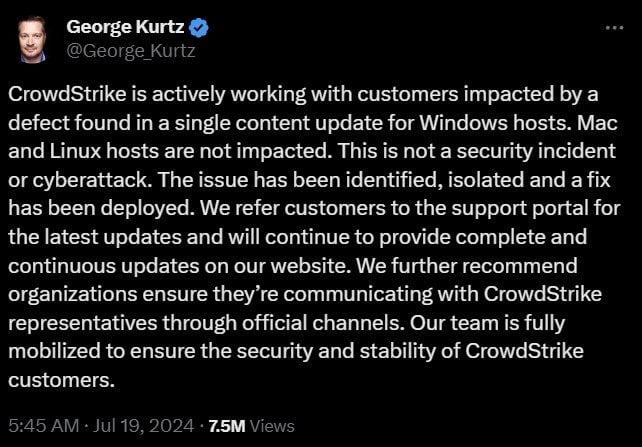The recent global IT outage exposed critical vulnerabilities. Learn how businesses can build resilience and protect their reputation in such crises.
The unprecedented global IT outage on the morning of July 19 exposed deep vulnerabilities across critical sectors, including transportation, healthcare, and government services.
This disruption traced back to a CrowdStrike software failure regarding an update, resulted in widespread flight cancellations, compromised emergency communication services, and halted operations at numerous institutions, severely impacting the customer experience. Passengers faced long delays and cancellations, patients encountered postponed medical procedures, and individuals found essential services disrupted.
The CrowdStrike software failure incident highlights the profound reliance on IT infrastructure and underscores the urgent need for robust system resilience and comprehensive contingency planning.
What does this mean for marketing and customer experience leaders who may be in such a crisis? According to Nichole Hinton, a CX practitioner and founder of Inspiruption, marketing, and customer experience leaders must prioritize strategies to prevent end users from overwhelming customer support representatives and protect their organization’s reputation. She added that marketing should focus on thorough customer education to eliminate skepticism, while CX should ensure support staff maintain professionalism during system outages.
Also Read: Death of Third-Party Data: A New Era for Marketers
Analyzing the Chain of Events of the CrowdStrike Software Failure
The Friday morning global IT outage revealed significant vulnerabilities in sectors across industries, notably affecting Microsoft-based systems. A faulty software update from CrowdStrike impacted approximately 8.5 million Windows devices. The aviation and healthcare industries were particularly hard hit, facing thousands of flight cancellations and delays and the postponement of elective medical procedures. This ripple effect extended into the weekend, with thousands of flights canceled on Saturday and over 1,000 additional cancellations on Sunday morning.
CrowdStrike CEO George Kurtz addressed the cause via Twitter, attributing the issue to a defect in a single content update for Windows hosts. This defect caused widespread system crashes or “blue screens of death.” This defect caused affected machines to enter a recovery boot loop, preventing proper startup. Kurtz clarified that this was a software glitch, not a cyberattack, underscoring the complexities of IT management and the importance of rigorous update protocols.

In the United States, the outage severely impacted emergency communication services. The Phoenix Police Department’s 911 dispatch center and similar services in Alaska and New Hampshire experienced technical difficulties, although emergency services remained operational. These incidents highlighted the need for resilient and redundant IT systems in emergency response operations.
Also Read: Top CCaaS Platforms to Transform Your CX
The Impact on Marketing and CX
CX leader Hinton, whose online magazine is dedicated to inspiration, spoke with CMSWire about the severe socio-economic impact of the CrowdStrike software failure and outage on critical industries such as airlines, banking, and healthcare.
“These three massive industries serve hundreds of millions a day, all over the world and now, people can’t fly, they can’t do their banking, and others may not get the responsive care they need. It’s a huge socio-economic impact,” said Hinton.
“For marketing and CX leaders, it means dropping everything else to focus on how to keep (end users) from overtaxing/overstressing their customer support representatives, as well as trying to salvage their reputation,” Hinton suggested that marketing’s job is to educate as deeply as possible to remove the skepticism from their customers’ minds, while CX’s role is to quickly retrain/remind their customer support staff to maintain the most professional demeanor possible when the system is down.
Hinton emphasized the importance of transparency and thorough education about the issue to instill confidence in customers regarding the next steps and timelines, the latter often being more critical.
Also Read: AI Cold Emails: Hit or Miss?
The Impact on Government Operations
The Department of Justice (DOJ) experienced disruptions, highlighting the broader implications of the outage on government operations. While law enforcement activities remained unaffected, the CrowdStrike software failure incident required immediate workarounds. It underscored the risk of opportunistic cyber threats, with malicious actors attempting to distribute malware disguised as software fixes.
The transportation sector was heavily impacted, with major metropolitan transit systems like D.C. Metro and New York City’s mass transit experiencing significant disruptions. International airports, including Berlin and Gatwick, faced IT issues, leading to delays and cancellations. U.S., American, United, and Delta Airlines requested a global ground stop, resulting in over 2,000 flight cancellations and 5,000 delays by noon. This cascade of issues underscores the interconnected nature of modern transportation networks and the essential need for robust IT contingency plans.
President Joe Biden’s briefing on the outage highlighted the federal response, with the White House coordinating efforts with CrowdStrike and affected organizations. Despite these interventions, CrowdStrike’s stock price dropped nearly 15% in early trading, reflecting market sensitivity to such disruptions and broader economic implications.
Steve Ross, director of cybersecurity, Americas at S-RM, a global corporate intelligence and cybersecurity consultancy, emphasized that this event should remind leaders across all areas of an organization about the importance of business continuity planning (BCP), an important strategic endeavor that organizations should undertake to prepare for outages of critical systems, services, vendors and facilities.










